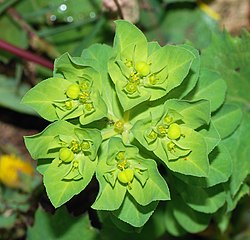| Euphorbia serrata | |
|---|---|
 | |
| Scientific classification | |
| Kingdom: | Plantae |
| Clade: | Tracheophytes |
| Clade: | Angiosperms |
| Clade: | Eudicots |
| Clade: | Rosids |
| Order: | Malpighiales |
| Family: | Euphorbiaceae |
| Tribe: | Euphorbieae |
| Subtribe: | Euphorbiinae |
| Genus: | Euphorbia |
| Species: | E. serrata |
| Binomial name | |
| Euphorbia serrata | |
Euphorbia serrata is a species of spurge known by the common names serrated spurge and sawtooth spurge, and also known as Tintern spurge and upright spurge. [1] It is native to Europe but it is present elsewhere as a weedy introduced species. [2] [3] This is a perennial herb growing anywhere from 20 centimetres to about half a metre in height. [2] The leaves are long and very narrow on most of the plant, with more oval-shaped leaves toward the tips of the stems. [2] [4] They are finely toothed. [2] At the ends of the branches are inflorescences of tiny flowers.[ citation needed ] The fruit is a spherical capsule about half a centimetre wide containing tiny gray seeds. [2]